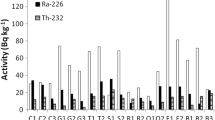Abstract
Tiruchirappalli district is naturally endowed with rich building material resources which are also used in neighboring districts. Hence, measurements of activity concentrations and absorbed dose rate of primordial radionuclides (238U, 232Th and 40K) in the rock samples collected from 14 sedimentary rocks and 9 igneous rocks were carried out employing gamma ray spectrometry. In sedimentary rocks the geometric mean activity concentrations of 238U, 232Th and 40K were found to be 7.4, 29.5 and 233.6 Bq kg−1, respectively. On the other hand in igneous rocks geometric mean activity concentrations of 238U, 232Th and 40K were distinctly higher and found to be 13.1, 105.7 and 888.8 Bq kg−1, respectively. The mean radium equivalent activity (Raeq) recorded in both sedimentary (20.8 Bq kg−1) and igneous rocks (245.4 Bq kg−1) were well within the limit prescribed for dwellings (370 Bq kg−1) except Vilathupatti (689.3 Bq kg−1) and Narthamalai (371.6 Bq kg−1). The mean absorbed dose rate from igneous rock (115 nGy h−1) exceeded the prescribed limit of 55 nGy h−1. The mean indoor annual effective dose from the sedimentary rock (0.056 mSv y−1) and igneous rock (0.580 mSv y−1) did not exceed the prescribed limit (1 mSv y−1) except the igneous rock from Vilathupatti (1.51 mSv y−1). The study concludes that sedimentary and igneous rocks analyzed were radiologically safe when used as building materials except igneous rock from Vilathupatti and Narthamalai.




Similar content being viewed by others
References
Damla N, Cevik U, Kobya AI, Celik A, Yildirim (2011) Assessment of natural radioactivity and mass attenuation coefficients of brick and roofing tile used in Turkey. Radiat Meas 46:701–708
EC (1999) Radiation protection 112. Radiological protection principles concerning the natural radioactivity of building materials. Directorate-General Environment, Nuclear safety and Civil Protection
UNSCEAR (2008) Report to the general assembly. Annex B Exposures of the public and workers from various sources of radiation
Kumar A, Kumar M, Singh B, Singh S (2003) Natural activities of 238U, 232Th and 40K in some India building materials. Radiat Meas 36:465–469
Ramasamy V, Murugesan S, Mullainathan S (2004) Gamma ray spectrometric analysis of primordial radionuclides in sediments of Cauvery River in Tamilnadu, India. Ecologica 2:83–88
Kpelgo DO, Lawluvi H, Faanu A, Awudu AR, Deatanyah P, Wotorchi SG, Arwui CC, Emi-Reynolds G, Darko EO (2011) Natural radioactivity and its associated radiological hazards in Ghanaian cement. Res J Environ Earth Sci 3(2):160–166
Sannappa J, Chandrashekara MS, Sathish LA, Paramesh L, Venkataramaiah P (2003) Study of background radiation dose in Mysore city, Karnataka State, India. Radiat Meas 37:55–65
Mishra UC, Sadasivan S (1971) Natural radioactivity levels in Indian soils. J Sci Ind Res 30:59–62
El-Arabi AM (2007) 226Ra, 232Th and 40K concentrations in igneous rocks from eastern desert, Egypt and its radiological implications. Radiat Meas 42:94–100
Cuney M, LeFort P, Wangeg (1987) Geology of granites and their metallogenetic relations. Science, Moscow, pp 852–873
Speer J, Solberg T, Becker S (1981) Petrography of the uranium-bearing minerals of the Liberty Hill Pluton. South Carolina: phase assemblages and migration of uranium in granitoid rocks. Ecom Geol 76:162–175
Sannappa J, Ningappa C, Prakash Narasimha KN (2010) Natural radioactivity levels in granite regions of Karnataka State. Indian J Pure Appl Phys 48:817–819
Deer WA, Howie RA, Zussman J (1997) Rock forming minerals: orthosilicates. Geological Society, London 918
OCED (1979) Exposure to radiation from the natural radioactivity in building materials. Reported by a group of experts of the OCED, Nuclear Energy Agency, Paris
UNSCEAR (1982) Ionizing radiation sources and biological effects. United Nations Scientific Committee on the effects of Atomic Radiation A/37/45, New York
Beretka J, Mathew PJ (1985) Natural radioactivity of Australian building materials, industrial wastes and by-products. Health Phys 48:87–95
Sroor A, Afifi S, Abdel-Haleem A, Abdel-Sammad M (2002) Environmental pollutant isotope measurements and natural radioactivity assessment for North Tushki area, South Western desert, Egypt. Appl Radiat Isot 7:1–10
Somlai J, Horvath M, Kanyar B, Lendvai Z, Nementh CS (1998) Radiation hazard of coal slags as building material in Tatabanya Town (Hungary). Health Phys 75(6):648–651
Slunga E (1988) Radon classification of building ground. Radiat Prot Dosimetry 24(114):39–42
Beck HL, Decompo J, Gologak J (1972) In situ Ge (Li) and NaI (Tl) gamma ray spectrometry. Health and safety Laboratory, AEC, New York, Reported by HASL, p 258
Kerur BR, Rajeshwari T, Anil Kumar S, Narayanhi K, Rekha AK, Hanumaiah B (2010) Radioactivity levels in rocks of North Karnataka, India. Indian J Pure Appl Phys 48:809–812
Wallova G, Kamala KA, Wallner G (2010) Determination of naturally occurring radionuclides in selected rocks from Hetaunda area, Central Nepal. J Radioanal Nucl Chem 203:713–718
Harb S, El-Kamel AH, Abd El-Mageed AI, Abbady A, Wafaa Rashed (2008) Concentration of U-238, U-235, Th-226, Th-232 and K-40 for some granite samples in Eastern Desert of Egypt. In: Proceeding of the 3rd Environmental Physics Conference, 19–23 Feb, pp 109–117
Tufai MN, Ahmed SM, Mirza NM, Khan HA (1992) Natural radioactivity from the building materials used in Islamabad and Rawalpindi, Pakistan. Sci Total Environ 121:283–291
Ahmed NK, Abbady A, El-Arabi AM, Michel R, El-Kamel AH, Abbady AGE (2006) Comparative study of the natural radioactivity of some selected rocks from Egypt and Germany. Indian J Pure Appl Phys 44:209–215
Anjos RM, Veiga R, Soare T, Santos AM, Aguiar JG, Frasca MH (2005) Natural radionuclide distribution in Brazilian commercial granites. Radiat Meas 39:245–253
Acknowledgments
The authors thankfully acknowledge Atomic Energy Regulatory Board, Govt. of India, Mumbai for funding (Project No: AERB/CSRP/45/05/2010) and Dr. M. T. Jose and Shri. S. Balasundar, Radiological Safety Division, Indira Gandhi Centre for Atomic Research, Kalpakkam for technical support and Prof. K. Ponnusamy, Chairman, J.J College of Engineering and Technology for providing facilities and support.
Author information
Authors and Affiliations
Corresponding author
Rights and permissions
About this article
Cite this article
Hameed, P.S., Pillai, G.S., Satheeshkumar, G. et al. Measurement of gamma radiation from rocks used as building material in Tiruchirappalli district, Tamil Nadu, India. J Radioanal Nucl Chem 300, 1081–1088 (2014). https://doi.org/10.1007/s10967-014-3033-1
Received:
Published:
Issue Date:
DOI: https://doi.org/10.1007/s10967-014-3033-1




